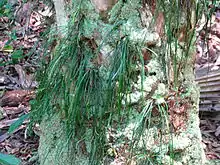Vittaria
Vittaria, the shoestring ferns,[1] is a genus of ferns in the Vittarioideae subfamily of the family Pteridaceae.[2] It had previously been placed in the family Vittariaceae,[3] but that family is no longer recognized.[4]
| Vittaria | |
|---|---|
 | |
| Vittaria lineata | |
| Scientific classification | |
| Kingdom: | Plantae |
| Clade: | Tracheophytes |
| Class: | Polypodiopsida |
| Order: | Polypodiales |
| Family: | Pteridaceae |
| Subfamily: | Vittarioideae |
| Genus: | Vittaria Sm. |
| Type species | |
| Vittaria lineata | |
Vittaria consists of epiphytes, with simple, entire, narrowly linear fronds.[5] It comprises six species, five of which are native to the neotropics. Vittaria isoetifolia is native to tropical Africa and islands of the southwestern Indian Ocean.[6] Vittaria isoetifolia and Vittaria lineata are known, albeit rarely, in cultivation.[7]
Vittaria was named by James Edward Smith in 1793 [8] in Mémoires de l'Académie Royale des Sciences (Turin).[9] The generic name is derived from the Latin, vitta, meaning "a band or ribbon".[10]
In 1990, Vittaria was defined broadly and estimated to have between 50 and 80 species.[3] The genus is difficult to divide into species, and many of the species are only doubtfully distinct. In a 1997 revision of the vittarioid ferns, only 34 species were recognized in Vittaria sensu lato.[6] Twenty of these were transferred to Haplopteris and eight to Radiovittaria, leaving only six in Vittaria.[6]
Species
Vittaria includes the following species:
- Vittaria appalachiana Farrar & Mickel 1991
- Vittaria dimorpha Müll.Berol. 1854 (= V. bradeorum Rosenst. 1925)
- Vittaria flavicosta Mickel & Beitel 1988
- Vittaria graminifolia Kaulf. 1824
- Vittaria isoetifolia Bory 1804
- Vittaria lineata (L.) Sm. 1793
- Vittaria longipes Sodiro 1893
- Vittaria scabrida Klotzsch ex Fée 1851 (doubtfully distinct from V. graminifolia)
Former species
Transferred to Haplopteris
- Vittaria anguste-elongata Hayata
- Vittaria angustifolia Blume
- Vittaria doniana Mettenius ex Hieron.
- Vittaria elongata Sw.
- Vittaria ensiformis Sw.
- Vittaria flexuosa Fée
- Vittaria forrestiana Ching
- Vittaria fudzinoi Makino
- Vittaria guineensis Desvaux
- Vittaria hainanensis C. Chr. ex Ching
- Vittaria himalayensis Ching
- Vittaria longicoma Christ
- Vittaria malayensis Holttum
- Vittaria modesta Handel-Mazzetti
- Vittaria owariensis Fée
- Vittaria scolopendrina (Bory) Schkuhr ex Thwaites
- Vittaria sikkimensis Kuhn
- Vittaria taeniophylla Copeland
- Vittaria volkensii Hieronymus
- Vittaria zosterifolia Willdenow
References
- "Vittaria". Natural Resources Conservation Service PLANTS Database. USDA. Retrieved 6 August 2015.
- Christenhusz, Maarten J. M.; Zhang, Xian-Chun; Schneider, Harald (18 February 2011). "A linear sequence of extant families and genera of lycophytes and ferns" (PDF). Phytotaxa. 19: 7–54. doi:10.11646/phytotaxa.19.1.2. ISSN 1179-3163.
- Karl U. Kramer. 1990. "Vittariaceae". pages 272-277. In: Klaus Kubitzki (general editor); Karl U. Kramer and Peter S. Green (volume editors) The Families and Genera of Vascular Plants volume I. Springer-Verlag: Berlin;Heidelberg, Germany. ISBN 978-0-387-51794-0
- Alan R. Smith, Kathleen M. Pryer, Eric Schuettpelz, Petra Korall, Harald Schneider, and Paul G. Wolf. 2008. "Davalliaceae". pages 443-444. In: "Fern Classification". pages 417-467. In: Tom A. Ranker and Christopher H. Haufler (editors). Biology and Evolution of Ferns and Lycophytes. Cambridge University Press. ISBN 978-0-521-87411-3
- David J. Mabberley. 2008. Mabberley's Plant-Book third edition (2008). Cambridge University Press: UK. ISBN 978-0-521-82071-4
- Edmund H. Crane. 1997. "A Revised Circumscription of the Genera of the Fern Family Vittariaceae". Systematic Botany 22(3):509-517.
- Anthony Huxley, Mark Griffiths, and Margot Levy (1992). The New Royal Horticultural Society Dictionary of Gardening. The Macmillan Press,Limited: London. The Stockton Press: New York. ISBN 978-0-333-47494-5 (set).
- Vittaria in International Plant Names Index. (see External links below).
- James Edward Smith. 1793. Mémoires de l'Académie Royale des Sciences (Turin) 5:413, pl. 9.
- Umberto Quattrocchi. 2000. CRC World Dictionary of Plant Names volume IV, page ?. CRC Press: Boca Raton; New York; Washington,DC;, USA. London, UK. ISBN 978-0-8493-2673-8 (set). (see External links below).
